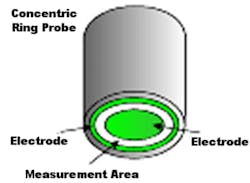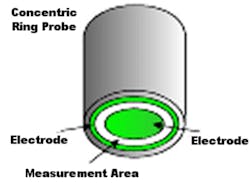Since the 1980s, static-protective packaging has been classified and tested by EIA-541-1988 and its predecessor, IS5A. This first effort to encompass all types of ESD-protective packaging classified material properties with static protection and provided test methods for evaluating those properties. While EIA-541 was leading edge in 1988, the many technical changes in materials, packaging, and test methodology have left it far behind current industry practices.
The ESD Association (ESDA) is the American National Standards Institute (ANSI)-recognized standards-development organization for static control in the United States. ESDA developed most of the currently recognized testing methods and practices for static control in electronics manufacturing, including the ANSI/ESD S-20.20 ESD Standard for the Development of an Electrostatic Discharge Program for Protection of Electrical and Electronic Parts, Assemblies, and Equipment (Excluding Electrically Initiated Explosive Devices). This standard has seen rapid adoption by OEMs, contract manufacturers, military and government agencies, and military suppliers as the single consistent methodology for implementing an ESD-control program.
To complement S-20.20, ESDA’s Packaging Standards Working Group currently is overhauling 541 to update and refine both the classification of material properties that impart static-protective capabilities to packaging and the testing methodologies used to evaluate these properties in packaging.
541 for 2001 and Beyond
This updated version of 541 will describe the packaging material properties needed to protect ESD-sensitive electronic items and provide the following:
- Properties/classifications or definitions of protective properties.
- Guidance for the application of these properties and the areas of the electronics manufacturing for their use.
- Technical requirements to confirm the functionality of the protective properties through testing.
This standard is designed to be a living document. While performance limits will be included, the actual test methods will not. This departure from 541-1988 will allow the new standard to keep up with technical progress.
In addition, ESD S-541 will move some items from 541-1988 to other locations. For instance, Appendix A Terms will be transferred to the ESDA Glossary.
Focus on Protective Properties
Almost any type of standard (not for static-sensitive items) packaging can provide mechanical and environmental protection. These packages, however, may harm static-sensitive electronic items by accumulating or discharging static electricity.
Most standard packaging is made from plastics that are insulative and retain static charge. Even paper-based products that contain some level of moisture can dry out and become a threat.
ESD-safe packaging is achieved by modifying standard packaging forms to prevent the package from causing static damage to devices. The package still provides mechanical and environmental protection. ESD-protective packaging has been modified even further to keep external sources of static electricity from damaging a packaged item. Since static protection primarily relies on electrical properties, mechanical and environmental requirements for packaging can be left to traditional packaging specifications.
Classifications
Material properties used to control static in packaging are low charging or antistatic; resistance including conductive (shielding), dissipative, and insulative resistance ranges; and discharge and E-field shielding. Each of the properties will be defined and described in detail in ESD S-541.
The most noticeable change replaces surface resistivity measurements in ohms per square with surface resistance in ohms. This change shifts the limits of the conductive, dissipative, and insulative ranges (Table 1).
Table 1. Dissipative Resistance Range Example
In ESD S-541, the shielding property will be expanded to include both resistance and attenuation as indications of shielding capability. Both discharge and E-field shielding are recognized.
Guidance
Many packaging engineers think in terms of specific package types, such as boxes or bags, instead of protective properties imparted to these package types. A guidance section will outline how to apply packaging with specific protective properties. Using a generic model showing the manufacture, transport, and use of electronics, the standard will demonstrate areas where packaging with certain protective properties should be used.
By understanding electrostatic threats that a sensitive item may encounter as well as the item’s sensitivity to those threats, packaging properties can be minimized, which reduces cost. However, the cost of making these determinations for threat and sensitivity may be greater and, considering the rate of device evolution, more time-consuming than selecting packaging that provides all of the protective properties.
Discussions of equipotential bonding and a brief survey of available ESD protective packaging types also will be found in ESD S-541.
Technical Requirements
541-1988 listed the performance limits for specific types of packaging, limiting the types of packaging the standard addressed. By changing the focus to properties instead of specific package types, ESD S-541 eventually will be useful in classifying and testing virtually any type of packaging for static control.
Performance limits for testing methods will be included for low-charging, resistance, and shielding properties. See Table 2 for an example of the technical requirements.
Table 2. Technical Requirements Example
References to specific test methods will include tribocharging (ESD ADV 11.2), surface resistance (ANSI/EOS/ESD S11.11), volume resistance (ESD STM11.12), and shielding (ANSI/ESD S11.31). The goal is to use test methods that allow evaluation of properties across multiple packaging types. For example, surface resistance of flat materials such as boxes, bags, and trays can be accomplished with S11.11.
However, small geometries and curved surfaces as in tape-and-reel cannot be evaluated with S11.11. A new two-point method will be added to address these measurements. This method will be useful for many types of packaging.
Still, some packaging types and properties require application-specific test methods. Measuring the resistance of loose fill (peanuts) with S11.11 or two-point resistance methods is not effective. A specific test method for loose-fill resistance will be added.
Over time, new test methods and limits will be added to ESD S-541 that address specific protective-property/package-type combinations that cannot be evaluated with broad-scoped, property-focused test methods.
Recommendations for package marking and quality traceability will be part of the technical requirements.
A Work in Process
This overview of the ESD S-541 draft includes information that may change as the standard moves through industry review. This preview of the standard is intended to generate interest and comment.
The ESDA Packaging Standards Working Group is always looking to add new resources and viewpoints to the group. If you use, specify, or test static-protective packaging and would like to become a reviewer of the draft standard, please contact me.
Making It ESD Safe
Standard packaging can be converted into ESD safe or even ESD protective by modifying the electrical characteristics. Since bags were one of the first packages to be made ESD safe, they illustrate a typical conversion.
Polyethylene bags are convenient for holding items and offer some mechanical protection. But the polyethylene plastic is insulative and accumulates damaging static electricity.
When a chemical antistat is added to the polyethylene, the amount of static electricity that accumulates reduces greatly. This low-charging polyethylene bag will not damage static-sensitive items by accumulation or discharge. This poly bag can become ESD protective by adding a conductive layer such as aluminum metallization. The low-charging static-shielding bag is low accumulating and shields enclosed items from static sources outside of the bag by attenuating ESD and E-fields.
Many standard packaging forms like boxes, trays, and clamshells have or now are following similar paths.
About the Author
Brent Beamer is the technical director for the ESD Products Division of Static Control Components. His activities in the ESDA include chairing the Packaging and Wrist Straps Standards Working Groups. Mr. Beamer has authored articles, papers, and tutorials about ESD for industry publications, the EOS/ESD Symposium, and the British Electrostatic Control Association. His degree in electronics is from Indiana State University. Static Control Components, P.O. Box 152, Sanford, NC 27331, 919-774-3808, e-mail: [email protected].
Published by EE-Evaluation Engineering
All contents © 2001 Nelson Publishing Inc.
No reprint, distribution, or reuse in any medium is permitted
without the express written consent of the publisher.
March 2001



